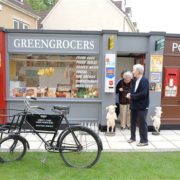Is this the future for nursing homes?
Quality of life: A ‘dementia village’ in the Netherlands is changing the way we think about care and aging
Published in the Vancouver Sun, December 7th, 2014
Weesp is an idyllic Dutch town with narrow cobblestone streets, canals, windmills, stores selling wooden shoes, and cheese shops. But what has put Weesp on the map are not the tourist attractions, but a neighbourhood designed and built exclusively for people with advanced stages of dementia who can no longer live independently.
De Hogeweyk Dementia Village is designed around the concept of quality of life and has six to eight people living in a home each with their own bedroom and shared living room, dining room and bathing rooms.
In the morning, residents wake up at their own time and gather around the dining room table, choosing what they would like for breakfast. A popular choice is pancakes. During breakfast, the conversation often focuses on what activities the residents want to do for the rest of the day. Following breakfast, a resident goes shopping in the local supermarket for groceries to be used for lunch and dinner.
A freezer at the entrance of the grocery store has frozen ice cream treats to satisfy a sweet tooth. In the same store, personal items such as incontinence products, medical supplies and cleaning supplies are purchased for the homes.
Once the resident has purchased her items, she walks back to her residence with the aid of her shopping cart. The supermarket is located in The Passage, a two-storey marketplace complete with a café, restaurant and art studio.
The Rembrandt Art Studio welcomes residents who arrive at their own pace and schedule. In the art studio, seniors paint like the Dutch masters Van Gogh and Vermeer. The art studio offers its residents a warm beverage to help keep their attention. When the drink is finished and the art is complete, the residents make their way to another attraction allowing space for other residents to paint.
The marketplace is large enough to feel like a town square and is used for group activities on rainy days. A market stand sells fresh-cut flowers, a newsstand has the daily papers, and large canvases featuring abstract art decorate the empty spaces on the walls.
Leaving the Marketplace, Main Street has the look and feel of its namesake. The pedestrian walkway with cobblestones has a café, hardware store for repairing bikes, walkers and other mobility aids to independence.
A physiotherapist provides both individual restorative therapy and group fitness exercises classes. A doctor’s office is located on the main drag, as is a modern beauty salon. One store front is called Mozart Hall and is decorated in Louis XIV style with classy dining tables and chairs and chandeliers. The hall is used for music therapy where residents create their own musical entertainment, much like they would have before moving to the dementia village.
A theatre hosts performances by local musicians and entertainers who champ at the bit to add this venue to their resumé. Another storefront is an activities booking travel agent who arranges trips to Amsterdam, De Hague, Haarlem, Delft and other regional cities and cultural attractions.
The main restaurant is decorated like a hip spot with perfectly poured espresso coffees and delicious biscotti. The lunchtime buffet menu is available to residents and guests from the local town and is a popular local eatery. The food quality is the same or better than the finest local restaurants and is part of the vibrant local food scene. It is a cool place to go out for a meal, not just a place to have a meal with grandma.
The buildings have the look and feel like the neighbouring buildings of both apartments and industrial park. The sounds of children playing can be heard in the distance as a school is located across the street with a soccer pitch visible for the residents to watch.
The homes are designed around people from similar backgrounds to encourage new friendships, to decrease aggressive behaviours, and to increase the chance of people getting along based on speaking the same language from their similar life experience. Separate houses are designed for Indonesian residents, while others are from urban areas and another for people who spent their lives farming.
Each home has distinctive features that help residents identify their home. One doorfront has a pair of wooden shoes, a bird feeder, and a small planter box with tulips and a mailbox with a large number 5 indicating the address.
The homes have their own patio with sturdy tables and chairs, covered shelter and a garden, which have been beautifully maintained. Park benches line outdoor space that is interconnected to other gardens sharing a common pathway for outdoor activities like Bochi, gravel field, life-size chess set, and lots of places to sit and take a break to watch what others are doing and to enjoy the independence of the outdoors.
An elevator without buttons automatically transports residents to and from their residences equipped with a motion sensor and electronic door closure sensors.
Gone are all the characteristics of an institutional living environment. Long corridors have been replaced with pedestrian boulevards and wandering paths; there are no sterile looking shiny floors reflecting the fluorescent tube lighting above. Care aides dressed in hospital scrubs do not rush residents to a main dining room to make it to a meal on time.
As demographic trends advance, homes for the aged will transform the aging experience with new models of care, and innovative living environments dignifying the lives of people with severe memory impairments. Theses communities are based on the need for a global response to the looming Alzheimer’s disease crisis that will triple in the next 40 years. New ways of caring for seniors in purpose-built environments as well as new options for living at home longer will perhaps mean that tomorrow’s seniors may never need a traditional nursing home.
This is not just a business model. It is a different way of thinking about the way people with advanced dementia experience the aging journey.
The Dementia Village is operated by Vivium, which operates other sites in the area and previously tested many of the design elements and philosophies to living and approaches to caring that have given the site an international reputation as a leading place for how innovative dementia care changes perceptions of what is important to residents, staff and families.
The village is modelled after the open-minded societal values of The Netherlands. If you walk down streets of any village, past the tourist attractions, you will find all of the same elements of living a meaningful life that you find in the Dementia Village. What is unique is the avant garde philosophy that freedom equals happiness. The seniors in the village can come and go as they please. Everywhere is safe within De Hogeeweyk. No one can leave the community unnoticed. As most seniors with advanced dementia cannot independently enter society, why not invite society into their purpose built communities?
Dan Levitt is executive director of Tabor Village in Abbotsford and an adjunct professor in the Gerontology Department at Simon Fraser University.







